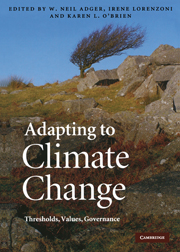Book contents
- Frontmatter
- Contents
- List of contributors
- Preface
- 1 Adaptation now
- Part I Adapting to thresholds in physical and ecological systems
- Part II The role of values and culture in adaptation
- Part III Governance, knowledge and technologies for adaptation
- 20 Whether our levers are long enough and the fulcrum strong? Exploring the soft underbelly of adaptation decisions and actions
- 21 Decentralized planning and climate adaptation: toward transparent governance
- 22 Climate adaptation, local institutions and rural livelihoods
- 23 Adaptive governance for a changing coastline: science, policy and publics in search of a sustainable future
- 24 Climate change, international cooperation and adaptation in transboundary water management
- 25 Decentralization: a window of opportunity for successful adaptation to climate change?
- 26 Adapting to climate change in Sámi reindeer herding: the nation-state as problem and solution
- 27 Limits to adaptation: analysing institutional constraints
- 28 Accessing diversification, networks and traditional resource management as adaptations to climate extremes
- 29 Governance limits to effective global financial support for adaptation
- 30 Organizational learning and governance in adaptation in urban development
- 31 Conclusions: Transforming the world
- Index
- References
22 - Climate adaptation, local institutions and rural livelihoods
Published online by Cambridge University Press: 31 August 2009
- Frontmatter
- Contents
- List of contributors
- Preface
- 1 Adaptation now
- Part I Adapting to thresholds in physical and ecological systems
- Part II The role of values and culture in adaptation
- Part III Governance, knowledge and technologies for adaptation
- 20 Whether our levers are long enough and the fulcrum strong? Exploring the soft underbelly of adaptation decisions and actions
- 21 Decentralized planning and climate adaptation: toward transparent governance
- 22 Climate adaptation, local institutions and rural livelihoods
- 23 Adaptive governance for a changing coastline: science, policy and publics in search of a sustainable future
- 24 Climate change, international cooperation and adaptation in transboundary water management
- 25 Decentralization: a window of opportunity for successful adaptation to climate change?
- 26 Adapting to climate change in Sámi reindeer herding: the nation-state as problem and solution
- 27 Limits to adaptation: analysing institutional constraints
- 28 Accessing diversification, networks and traditional resource management as adaptations to climate extremes
- 29 Governance limits to effective global financial support for adaptation
- 30 Organizational learning and governance in adaptation in urban development
- 31 Conclusions: Transforming the world
- Index
- References
Summary
Introduction
To understand the role of institutions in future adaptation of rural livelihoods to climate change, especially by poorer and more marginal groups, it is essential to attend to the historical repertoire of strategies used by rural populations. Natural resource-dependent rural households are likely to bear a disproportionate burden of the adverse impacts of climate change – droughts, famines, floods, variability in rainfall, storms, coastal inundation, ecosystem degradation, heat waves, fires, epidemics, and even conflicts. In some parts of the world, these effects may already be in play with potentially disastrous consequences for the poor (Adger et al., 2007). Many households in vulnerable regions could periodically be driven into destitution and hunger and find it difficult afterwards to recover.
Even as it is clear that poorer and disadvantaged groups around the world will suffer greatly from climate change, it bears remembering that the rural poor have successfully faced threats linked to climate variability in the past. History, as the cliché goes, may be a poor guide, but it is the only available guide. Even if future climate-related threats might appear prospectively to be historically unprecedented, analysing past impacts and responses is undoubtedly important in understanding the feasibility of future initiatives. After all, the only alternative to adaptation is extinction unless the world strictly and immediately limits its future emissions, an outcome surely in doubt given the record of the past decade.
- Type
- Chapter
- Information
- Adapting to Climate ChangeThresholds, Values, Governance, pp. 350 - 367Publisher: Cambridge University PressPrint publication year: 2009
References
- 57
- Cited by

